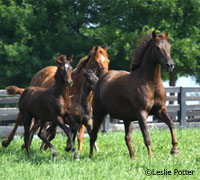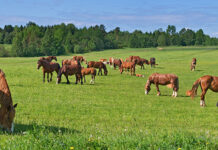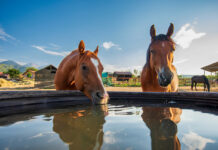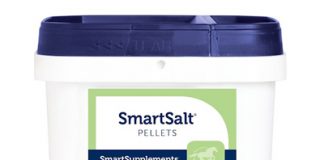 From birth to 2 years of age, a young horse reaches about 90 percent of his eventual adult weight and height. Also during a horse’s first two years, he develops the muscles, tendons, organs and bone he’ll need for a lifetime of activity. Good nutrition is critical during this growth phase of a horse’s life for the animal to reach his full genetic potential. This critical growth phase begins while the foal is developing in his dam’s uterus. Without it, growth may be stunted or orthopedic problems may result.
From birth to 2 years of age, a young horse reaches about 90 percent of his eventual adult weight and height. Also during a horse’s first two years, he develops the muscles, tendons, organs and bone he’ll need for a lifetime of activity. Good nutrition is critical during this growth phase of a horse’s life for the animal to reach his full genetic potential. This critical growth phase begins while the foal is developing in his dam’s uterus. Without it, growth may be stunted or orthopedic problems may result.
Good nutrition for foals starts with good nutrition for their dams. During the average 340 days between conception and foaling, the mare provides 100 percent of the nutrition needed by the growing fetus. The lactating mare then provides 100 percent of her suckling foal’s nutritional needs up to approximately 2 months of age. Adequate amounts of protein, energy (calories), vitamins and trace minerals are needed in the mare’s diet for both mare and baby to thrive.
Through her 11-month pregnancy, the typical 1,200-pound mare gains between 175 and 225 pounds. Fluids, placental tissue and the fetus itself (120 pounds is a typical weight for a newborn foal) account for most of that weight, along with fat reserves the mare will need when she begins producing milk.
Nutritional research has dispelled many myths about weight gain during pregnancy and about feeding pregnant mares. For example, unlike lactating mares whose calorie needs are enormous, nutritionists recommend that during the first trimester of pregnancy, mares without foals at their sides be fed according to their work level, as with any other mature horse. At this stage, the fetus weighs less than 5 pounds and makes the fewest demands on the mare’s body. In fact, overfeeding the mare with a vitamin/mineral-fortified grain mix, the best alfalfa hay and three or four vitamin/mineral supplements as “insurance” may actually harm the fetus’s early development by getting nutrients out of balance. A pregnant mare in light work that does not have a nursing foal needs a total daily ration (hay plus grain) equivalent to only 1.5 to 2 percent of her body weight during the first trimester, compared to the lactating mare, which requires a total daily ration equivalent to 3 percent of her body weight.
Recent research indicates that there is more fetal growth in the second trimester than previously thought. This means that the 100- to 150-pound weight surge once thought to occur late in the mare’s pregnancy may actually occur sooner or over a longer period of time. During the second trimester, the mare needs a daily ration equal to 2 to 2.25 percent of her body weight to help her start building the critical fat reserves she will draw on when she begins nursing.
Crude protein, vitamin and trace mineral levels need to be increased about midway through the second trimester to feed fetal tissue growth. Pay particular attention to the levels of calcium, phosphorous, copper, zinc, manganese and selenium. If the mare is fed alfalfa hay, be sure her diet is balanced for calcium and phosphorous, since the calcium:phosphorous ratio of alfalfa can be as high as 10:1. The mare’s total diet should contain at least .4 percent calcium and .3 percent phosphorous.
There is less concern today than in the past about excessive weight gain in mares during late pregnancy. While surplus fat can stress the mare’s cardiovascular system, ligaments and joints, recent research indicates that excess weight is not necessarily harmful to the mare or fetus. Research has disproved long-held beliefs that excess fat affects rebreeding success or fetal weight.
There is actually more potential harm in bringing a mare into late pregnancy in thin condition. Thin mares have a higher incidence of embryonic death and lower foal birth rates. They also have no energy reserves for themselves or the birth process. They may have lower resistance to infection and therefore fewer antibodies to pass on to their foals. Their milk production will be scanty, and their suckling foals will be hungrier. Conception rates for thinner mares at rebreeding are also lower. If a mare enters the last trimester of her pregnancy in thin condition, this is one time to pour on the grain to achieve a large weight gain before foaling. Add to 1 pound of a grain mix fortified for pregnant mares to her total ration every fourth day, but do not let grain exceed 40 percent of her total daily ration.
The mare coming into late pregnancy in good flesh needs 2.25 to 2.5 percent of her body weight daily in feed, plus more protein, vitamins and minerals than she did during the first two trimesters. Look for grain mixes specially designed for pregnant mares that have high-quality protein sources, such as milk or soybean products, and fortification with extra calcium, phosphorous and trace minerals.
Lactation
Nursing makes the greatest nutritional demands on a mare in any phase in the reproductive cycle, and many mares are underfed while nursing. Lactating mares need as much or more energy in their diets as hardworking performance horses. However, compared to a performance horse whose energy needs increase gradually throughout his training regime, the lactating mare’s energy needs increase literally overnight.
For the first four months of their lives, foals gain between 3 and 5 pounds daily, and in the first two months, a foal depends on its dam for 100 percent of his nutrition. The mare’s energy needs are double what they were in her second trimester and three times what they were in the first. Her protein, vitamin and mineral needs are at least 25 percent higher, too. Without sufficient calories in her diet, a lactating mare’s hipbones and ribs sometime seem to appear overnight. When that happens, it means she is breaking down her own body reserves to produce milk. This not only hurts the mare, but it can also jeopardize any new fetus she may be carrying if she was rebred.
Give the lactating mare 3 percent of her body weight daily in feed. Since she can only eat a certain amount of hay daily, the best way to increase her calories is by increasing her grain intake. To avoid colic, begin switching to post-foaling grain levels about a week to 10 days before the mare’s expected foaling date, adding from .5 to 1 pound of grain every fourth day until reaching her new feeding level. Feed a grain mix fortified especially for broodmares to supply her protein, vitamin and mineral needs. This is also the time to splurge on the best-quality grass hay or alfalfa you can find so that the mare gets maximum nutrition from her forage.
While it is difficult to influence the composition of a mare’s milk through her diet, the quantity of milk a mare produces can be influenced by her feeding level. More grain (increased calories) produces more milk. The size of a mare’s bag is a poor indicator of her overall milk production, but if the mare has a small udder and the foal is nursing constantly, the foal is probably hungry. If feeding the mare more calories does not increase her milk supply enough to satisfy the foal’s needs, the foal may need supplemental creep feeding.
Milk is 98 percent water, and at peak lactation a mare produces about 4 gallons of milk daily. Lactating mares need ample supplies of water, about three times what a nonlactating mare requires. A 5-gallon bucket filled twice daily will notsupply her needs. Because grass contains 80 to 90 percent water, the pastured lactating mare can supply much of her increased water needs through grazing, although fresh water should always be available.
Suckling Foals
Because of their small digestive tracts, foals eat many small, frequent meals. It is normal for suckling foals to nurse for one to two minutes three to seven times an hour. Excessive bouts of nursing, a foal that is constantly butting the mare’s udder, a mare that is antagonistic because the foal is continually trying to nurse or below-normal weight gains all point to poor milk production.
Before he is 2 or 3 months old, the foal’s immature digestive tract cannot break down and utilize grain-based creep feeds. His teeth are not equipped for chewing grains well, and his gut does not yet have a full complement of microbes and enzymes to process grain. Offering creep feeds based on high-quality milk-protein sources can help the suckling whose dam is not a good milker. On the whole, however, nutritionists advise creep feeding cautiously because excessive creep feeding pushes growth and risks developmental orthopedic disease (DOD).
The rule is to creep feed conservatively. At various times, nutritionists have implicated high protein levels, excess calories and various minerals as the culprits responsible for various orthopedic problems in young, growing horses. Current research indicates the problem is not any one of these factors but rather the balance among them. For example, if high protein levels push growth but the minerals necessary for sound bone development are missing from the diet, DOD can result. Foals being pushed on high-protein creep feeds with low mineral levels are not the only ones at risk. However, weanlings on low-protein grass pastures that receive high-energy grain mixes that are not balanced for minerals can have problems, too.
When creep feeding a nursing foal is necessary, the foal should get no more than .5 to .75 pound of creep feed per 100 pounds of body weight daily, plus top-quality hay fed free choice. Look for a creep feed especially blended for foals that is about 16 percent protein, .8 percent calcium and .6 percent phosphorous. The calcium:phosphorous ratio should be around 1:1 and never more than 3:1. Check the ingredients listing for high-quality protein sources, such as dried milk products or soybean meal, which provide the amino acids needed for growth.
A 16-percent crude-protein grain mix intended for hardworking adult horses will not be suitable for creep feeding because the balance of its protein, energy and minerals may be unsuitable for good growth. While protein sources such as cottonseed meal, linseed meal or corn gluten meal may be acceptable in adult horse diets, they do not provide the amino acids needed for good growth in young horses.
Weaning and Beyond
By the time the foal is 4 to 5 months old, his digestive tract has developed sufficiently to process grain and he is psychologically ready to leave his dam. Start the weaning process by cutting the mare’s calories to reduce her milk production. About a week prior to weaning, cut calorie intake about 20 percent by halving the mare’s grain ration. Three days before weaning, cut calories about 20 percent again by removing all grain. This gradual tapering of the mare’s feed intake helps her begin drying up so she will be less likely to have problems with a swollen udder or mastitis at weaning time. Secondly, less milk means a hungrier foal that will become more interested in other sources of food and water.
After the mare and foal are separated, keep the mare off grain for about three more days to help dry her udder. If she is carrying a new fetus, do not keep her off grain any more than a week after weaning, or the new foal she is carrying may suffer nutritionally. Add grain back into her diet at the rate of about ½ pound every three or four days until she is back at the desired maintenance level.
The weanling needs about 3 percent of his body weight daily in feed. While some of this should be supplied by a 14- to 16percent crude-protein grain mix, do not feed grain free choice to weanlings. Foals easily overeat with the result being enterotoxemia or DOD. Good-quality hay, on the other hand, should be available free choice. Remember that the minerals in the grain mix or supplements fed should complement the grass or alfalfa hay offered so that overall protein, calories and minerals stay balanced in the total ration.
The enormous daily weight gain during the foal’s first six months gradually tapers off as he approaches a year old. Continue to feed good-quality hay supplemented with a grain mix formulated to balance the minerals in the hay, but drop the crude protein level in the grain mix to 10 to 12 percent. As the yearling approaches 2 years of age, he will have gained more than 90 percent of his adult weight and height and, instead of growth, the animal’s work level will become the major determinant of his ideal feeding program.
Further Reading
Milk Alternatives for Foals






great information,easy to read & covered a
full life cycle
hi i iam new to horses and i have a mare in foal and this article Feeding Broodmares and Foals is a big help!! thank jr taylor
Great info! I hope that everyone has a great and safe weekend, plus I hope that they had a nice Veteran’s Day! That goes for last year and all the other years that I’ve missed.
Excellent points.
This was a big help I just bought a horse and baby the goal is 5 months old and we think she is prago again so it was a big help on feeding